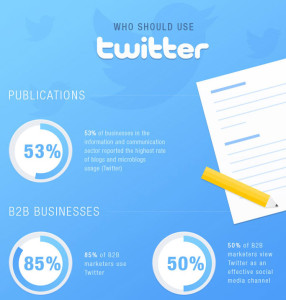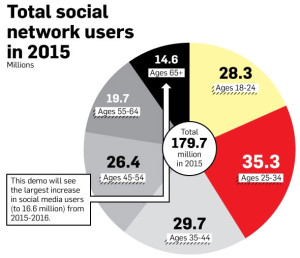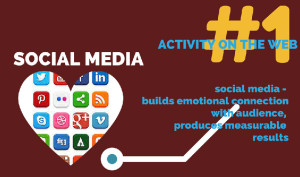Business and consumer marketers are nearly unanimous in their belief in the importance of social media to marketing activities.
As noted below, the money is following that belief: social media now accounts for about 11% of all digital marketing outlays, and spending on social media marketing will total nearly $10 billion this year.
Still, marketers sometimes struggle with strategy, tactics, and measurement in social media marketing.
Social Media Marketing: Key Stats
- Social Media’s Share in Digital Marketing: Social media accounts for 11% of all digital marketing spending, with spending reaching nearly $10 billion annually.
- Response Expectations: 53% of consumers on Twitter expect a response from brands within an hour, especially for complaints.
- Influence on Buying: 75% of consumers use social media in their buying process, underscoring its impact on purchase decisions.
- Age-Based Platform Preferences: 63% of U.S. Facebook users and 58% of Pinterest users are 35 or older, while younger audiences favor Instagram and Twitter.
- Content Sharing: 49% of people share online content weekly, boosting reach through user engagement.
- Social Media and Customer Service: While 67% of consumers have used social media for customer support, only 2% actually prefer it over other channels.
- Social Recommendations: 28% of users aged 18-34 are influenced by friends’ social recommendations, while this drops to 4% for those 65+.
5 Actionable Key Takeaways for Social Media Success
- Be responsive. People expect to hear back from the brands they interact with on Twitter and other social networks. And when they report a problem or issue, they expect to hear back quickly: 53% of consumers on Twitter expect a response within the hour. Furthermore, nearly half of all social media users share content with their friends, family and co-workers at least weekly; so if they have a bad experience with your brand, the word is likely to spread.
- Strategize and measure. 88% of marketers believe social media marketing is important, and 75% of consumers say they use social media in the buying process. Yet nearly half of marketers only “somewhat agree” that analyzing social media engagement can help improve the bottom line. The key to making social media marketing effective at the business level is to have a strategy in place and measure key performance indicators. Unfortunately, strategy and measurement are cited as the top two challenges faced by social media marketers. They aren’t easy, but those who get these two areas right will succeed.
- Know your market (B2B). Twitter is the place to engage with companies: While just 20 of the of Fortune 500 companies actually engage with their customers on Facebook, 83% have a presence on Twitter—as do 76% of the NASDAQ 100, 100% of Dow Jones companies, and 92% of the S&P 500. For reaching top executives though, LinkedIn is the place to be. Though only 32% of Fortune 500 CEOs have a presence on any major social network, the majority of those (25% of the total) are on LinkedIn. And 59% of executives prefer video content to text.
- Know your market (B2C): Nearly three-quarters of adult Internet users in the U.S. are active on at least one social network (predominantly Facebook)—but not all use social media the same way or have the same expectations. For example, while just 2% of all consumers prefer social media over other channels for customer service, 27% of Gen Y-ers favor it. On the other hand, consumers aged 55-64 are more than twice as likely to engage with brand content as those younger than 28. Older social media users favor Facebook and Pinterest; the 34-and-under crowd dominates on Tumblr and Instagram.
- Get social PR right. While journalists are open to connecting with and being contacted by PR pros using social media, they prefer email for pitches and follow up. But 76% of journalists say they feel pressure to think about their story’s potential for sharing on social media platforms—so make sure that’s part of the pitch.
There’s much more in this collection of two and half dozen sensational social media marketing and social PR facts and statistics:
16 Social Media Marketing Stats
1. People ages 55-64 are more than twice as likely to engage with a brands’ content than those 28 or younger. (Social Media Today)
2. People share content 49% more on weekdays than on weekends. (Social Media Today)
3. On average, social media accounts for 11% of digital marketing spending. (MarketingProfs)
4. 72% of adult internet users in the U.S. are now active on at least one social network, up from 67% in 2012. (Marissa’s Picks)
5. More than 70% of users expect to hear back from the brand they’re interacting with on Twitter, and 53% want a response within the hour. (Marissa’s Picks)
6. 49% of people say they share online content they like with friends, family or co-workers at least weekly. (Ber|Art)

7. 86% of marketers believe that social media is important for their business. (Ber|Art)
8. U.S. spending on social media marketing will reach $9.7 billion in 2015. (MediaPost)
9. Although 88% of marketers believe social media marketing is important, nearly half (48%) only “somewhat agree” that analyzing social media engagement can help improve the bottom line, and 15% don’t think analyzing social engagement matters at all. (eMarketer)
10. The top four challenges faced by social media marketers worldwide are assessing the effectiveness of social media activities (cited by 67% of marketers); designing an overall social media strategy (62%); making social media data actionable (61%); and educating staff on how to use social media (59%). (eMarketer)
11. Product/brand recommendations on social media mean more to younger people. 28% of those aged 18-34 say they are “very” or “fairly” likely to make a purchase based on a friend’s social media post, while just 33% say they are “not at all likely” to do so. The first figure gets smaller and the second larger with age; among those 65 and over, just 4% are likely to make a purchase based on a social media recommendation, while 78% are not at all likely. (Heidi Cohen)
12. 75% of customers say they use social media as part of the buying process. (Biznology)
13. 56% of marketers do not use any form of paid promotions on social media. (Cision)
14. Consumers may use social media for customer service, but they don’t love it. Although 67% of consumers have already used a company’s social media channel for customer service, just 2% say they prefer it over other options. Phone and email remain the most popular channels (66% combined). (MediaPost)
15. However–27% of Gen Y-ers favor social media for customer service. (MediaPost)

16. Facebook and Pinterest are among the “oldest” social networks in terms of their member demographics; 63% of U.S. Facebook users and 58% of those on Pinterest are age 35 and older. On the other hand, the 34-and-under crowd dominate on Tumblr (just over 50%) and Instagram (60%). Twitter is more balanced. (Social Media Today)
6 Social PR Statistics and Facts
17. While many journalists say they’d like PR pros to contact them via social media, less than half of PR practitioners have successfully pitched a journalist or outlet via social. So while engaging on social is a great add-on, traditional methods such as using a media database to target specific beats remains ever-important. (Cision)
18. The top three measures used by PR pros to show social media success increased website traffic (64%), increased engagement (61%) and increased followers (59%). (Cision)
19. 88% of PR professionals say their businesses or clients regularly engage on Facebook—more than any other social media platform. Twitter came in a close second at 85%. (Cision)

20. Journalists receive, on average, 50-100 press releases every week. 44% prefer to receive them in the morning. 68% just want the facts. (B2B PR Sense Blog)
21. 76% of journalists say they feel pressure to think about their story’s potential for sharing on social media platforms. 64% say they prefer that follow-up on “pitches” be done via email rather than phone. (BentoBox Media)
22. When using video, 74% of journalists prefer content created by their own organizations. Just 3% use corporate / branded videos. (BentoBox Media)
6 Facts and Stats About Executive and Enterprise Social Media Use
23. Just 32% of Fortune 500 CEOs have a presence on any of the major social networks (Twitter, Facebook, LinkedIn, Google+, and Instagram). Most of those have a presence on only one platform, with the majority (25.4% of the total) on LinkedIn. Mark Zuckerberg is the only Fortune 500 CEO on all five major social networks — and he owns two of them. (MediaPost)
24. 59% of senior executives prefer video over text. (41 Stories)
25. Just 20 of the Fortune 100 comnpanies actually engage with their customers on Facebook. (i-SCOOP) [IMAGE maybe – good one – social customer service]
26. On a company level, 83% of the Fortune 500 had a Twitter presence in 2014, up from 77% the year before. 80% were on Facebook, up from 70%. (Sword and the Script)
27. Among 500 of the largest U.S. companies, Cisco and HP score first and second in their use of social media for corporate communications. But Facebook is only number 242, and Apple comes in 416th place. According to research by Investis, “Facebook was marked down because it did not engage with its corporate audience using the other social media platforms reviewed. Even on its own platform, Facebook’s investor relations page fell well short of best practice. For example, it does not use videos or hashtags and it does not appear to have responded to any of the posts left by users.” (Virtual Press Office)
28. Only 76% of Nasdaq 100 companies maintain a corporate Twitter account which compares with 100% of the Dow Jones and 92% of the S&P 100. (Virtual Press Office)
3 SMB Social Media Marketing Stats
29. 75% of SMBs use social media to promote their businesses–more than any other media category. (MediaPost)
30. Social media is not only number one in terms of utilization by SMBs, it is also number one in share of SMB media spending (21% of total media budgets). (MediaPost)
31. In the average firm of 100-500 employees, seven people are involved in a buying decision. (Biznology)
8 Tips for Developing a Cross-Platform Social Media Strategy
- Identify Your Goals and KPIs: Start by defining clear objectives for each platform, such as brand awareness, lead generation, or customer engagement. Choose metrics that align with these goals, like reach, engagement rates, or conversions.
- Know Your Audience by Platform: Research where your audience spends their time and what content they engage with. For example, LinkedIn tends to attract B2B professionals, while Instagram and TikTok appeal to a younger, more visually-oriented audience.
- Create Platform-Specific Content: Tailor your content to each platform’s strengths and audience expectations. Use professional updates on LinkedIn, visual storytelling on Instagram, and quick, engaging posts on Twitter.
- Maintain Brand Consistency: Ensure your brand voice, logo, and messaging are consistent across all platforms, while adapting to each platform’s format. Consistency builds trust and helps your audience recognize your brand instantly, no matter the channel.
- Schedule Wisely with Data-Driven Insights: Use social media analytics to identify peak engagement times on each platform, and schedule posts to align with these periods. Most social media platforms offer insights that help determine when your audience is most active.
- Engage Actively and Monitor Feedback: Respond promptly to comments, mentions, and direct messages. Cross-platform strategies thrive when there’s real engagement, so ensure you’re monitoring each platform and interacting with followers.
- Use Cross-Promotion, Not Duplication: Instead of reposting the exact same content on each platform, adjust your messaging slightly for each audience. Cross-promote by sharing teasers on one platform and linking to more in-depth content on another.
- Analyze and Optimize Regularly: Use analytics to track your performance and identify top-performing content. Adjust your strategy based on what resonates most with your audience, as each platform will offer unique insights.
Best Practices for Engaging B2B and B2C Audiences on Social Media
For B2B Audiences:
- Use LinkedIn as Your Hub: LinkedIn is essential for B2B. Share thought leadership, industry insights, and company news to position your brand as an authority.
- Share Educational and Value-Driven Content: B2B audiences value informative content, such as white papers, webinars, and case studies. Highlight data, research, and industry trends that help them solve specific challenges.
- Use Employee Advocacy: Encourage your employees to share company updates on their personal profiles to reach a wider audience authentically.
- Run Targeted Ads to Reach Decision-Makers: LinkedIn and Twitter’s ad targeting features allow you to reach professionals based on job title, industry, or company size, increasing your reach among decision-makers.
- Host Webinars and Live Q&A Sessions: Provide value by sharing expertise and answering questions in real time. Webinars are especially effective for showcasing knowledge and interacting with industry peers.
For B2C Audiences:
- Use Visual Platforms like Instagram and TikTok: Consumers expect brands to show up where they are most active. Embrace visually engaging formats like short videos, stories, and image-based posts.
- Run Exclusive Offers and Promotions: Incentivize engagement by offering special discounts or early access to new products. B2C audiences are often drawn to deals, contests, and promotions.
- Use Influencer Partnerships: Influencers can help build trust with new audiences by promoting your products to their followers. Choose influencers whose audience aligns with your brand.
- Humanize Your Brand with Stories and Behind-the-Scenes Content: Consumers respond well to authentic, relatable content. Share stories, customer testimonials, or behind-the-scenes insights to build a personal connection.
- Engage with Customers in Real-Time: B2C audiences value quick responses and proactive engagement. Use social listening to identify conversations about your brand and respond to customer queries or compliments.
Wrapping Up
Social media marketing continues to grow in significance, shaping how brands connect with their audiences, foster loyalty, and drive conversions.
While the benefits of social media marketing are clear, success requires a thoughtful approach with a solid strategy, audience-specific insights, and ongoing measurement. As trends shift, brands must stay adaptable, focusing on engagement, responsiveness, and data-driven decision-making.
Whether through tailored content, prompt customer service, or strategic ad spending, social media remains an essential tool for building lasting customer relationships and achieving measurable business outcomes.